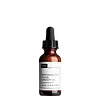What's inside
What's inside
 Key Ingredients
Key Ingredients

 Benefits
Benefits

 Concerns
Concerns

 Ingredients Side-by-side
Ingredients Side-by-side

Water
Skin ConditioningCaprylic/Capric Triglyceride
MaskingPropanediol
SolventGlycerin
HumectantPrunus Amygdalus Dulcis Oil
Skin ConditioningCetyl Alcohol
EmollientSucrose Stearate
EmollientPolyglutamic Acid
Skin ConditioningRubus Fruticosus Fruit Extract
AstringentVinegar
Phytic Acid
Tocopherol
AntioxidantTocopheryl Acetate
AntioxidantGlyceryl Oleate Citrate
EmulsifyingPolyglyceryl-6 Polyricinoleate
EmulsifyingHydroxyacetophenone
AntioxidantXanthan Gum
Emulsifying1,2-Hexanediol
Skin ConditioningCaprylyl Glycol
EmollientPotassium Hydroxide
BufferingPhenoxyethanol
PreservativeSodium Hydroxide
BufferingSodium Benzoate
MaskingPotassium Sorbate
PreservativeMica
Cosmetic ColorantCI 77891
Cosmetic ColorantIron Oxides
Water, Caprylic/Capric Triglyceride, Propanediol, Glycerin, Prunus Amygdalus Dulcis Oil, Cetyl Alcohol, Sucrose Stearate, Polyglutamic Acid, Rubus Fruticosus Fruit Extract, Vinegar, Phytic Acid, Tocopherol, Tocopheryl Acetate, Glyceryl Oleate Citrate, Polyglyceryl-6 Polyricinoleate, Hydroxyacetophenone, Xanthan Gum, 1,2-Hexanediol, Caprylyl Glycol, Potassium Hydroxide, Phenoxyethanol, Sodium Hydroxide, Sodium Benzoate, Potassium Sorbate, Mica, CI 77891, Iron Oxides
Water
Skin ConditioningCaprylyl Methicone
Skin ConditioningTitanium Dioxide
Cosmetic ColorantIsodecyl Neopentanoate
EmollientMica
Cosmetic ColorantTrimethylsiloxysilicate
EmollientCetearyl Alcohol
EmollientPropanediol
SolventCaramel
Cosmetic ColorantCeteth-20 Phosphate
CleansingCI 77491
Cosmetic ColorantSodium Hyaluronate
HumectantPseudoalteromonas Exopolysaccharides
Skin ConditioningAllantoin
Skin ConditioningGlucose
HumectantFructose
HumectantMaltose
MaskingTrehalose
HumectantSodium Lactate
BufferingSodium PCA
HumectantUrea
BufferingPolypodium Vulgare Rhizome Extract
HumectantCetraria Islandica Thallus Extract
HumectantSphagnum Magellanicum Extract
Skin ConditioningPentylene Glycol
Skin ConditioningGlycerin
HumectantCarrageenan
Acacia Senegal Gum
MaskingMethyl Methacrylate/PEG/PPG-4/3 Methacrylate Crosspolymer
Dicetyl Phosphate
EmulsifyingSynthetic Fluorphlogopite
Tin Oxide
AbrasiveSodium Chloride
MaskingSodium Hydroxide
BufferingSodium Salicylate
PreservativeTriethanolamine
BufferingCitric Acid
BufferingPhenoxyethanol
PreservativeChlorphenesin
AntimicrobialWater, Caprylyl Methicone, Titanium Dioxide, Isodecyl Neopentanoate, Mica, Trimethylsiloxysilicate, Cetearyl Alcohol, Propanediol, Caramel, Ceteth-20 Phosphate, CI 77491, Sodium Hyaluronate, Pseudoalteromonas Exopolysaccharides, Allantoin, Glucose, Fructose, Maltose, Trehalose, Sodium Lactate, Sodium PCA, Urea, Polypodium Vulgare Rhizome Extract, Cetraria Islandica Thallus Extract, Sphagnum Magellanicum Extract, Pentylene Glycol, Glycerin, Carrageenan, Acacia Senegal Gum, Methyl Methacrylate/PEG/PPG-4/3 Methacrylate Crosspolymer, Dicetyl Phosphate, Synthetic Fluorphlogopite, Tin Oxide, Sodium Chloride, Sodium Hydroxide, Sodium Salicylate, Triethanolamine, Citric Acid, Phenoxyethanol, Chlorphenesin
Alternatives
Ingredients Explained
These ingredients are found in both products.
Ingredients higher up in an ingredient list are typically present in a larger amount.
Glycerin is already naturally found in your skin. It helps moisturize and protect your skin.
A study from 2016 found glycerin to be more effective as a humectant than AHAs and hyaluronic acid.
As a humectant, it helps the skin stay hydrated by pulling moisture to your skin. The low molecular weight of glycerin allows it to pull moisture into the deeper layers of your skin.
Hydrated skin improves your skin barrier; Your skin barrier helps protect against irritants and bacteria.
Glycerin has also been found to have antimicrobial and antiviral properties. Due to these properties, glycerin is often used in wound and burn treatments.
In cosmetics, glycerin is usually derived from plants such as soybean or palm. However, it can also be sourced from animals, such as tallow or animal fat.
This ingredient is organic, colorless, odorless, and non-toxic.
Glycerin is the name for this ingredient in American English. British English uses Glycerol/Glycerine.
Learn more about GlycerinMica is a naturally occurring mineral used to add shimmer and color in cosmetics. It can also help improve the texture of a product or give it an opaque, white/silver color.
Serecite is the name for very fine but ragged grains of mica.
This ingredient is often coated with metal oxides like titanium dioxide. Trace amounts of heavy metals may be found in mica, but these metals are not harmful in our personal products.
Mica has been used since prehistoric times throughout the world. Ancient Egyptian, Indian, Greek, Roman, Aztec, and Chinese civilizations have used mica.
Learn more about MicaPhenoxyethanol is a preservative that has germicide, antimicrobial, and aromatic properties. Studies show that phenoxyethanol can prevent microbial growth. By itself, it has a scent that is similar to that of a rose.
It's often used in formulations along with Caprylyl Glycol to preserve the shelf life of products.
Propanediol is an all-star ingredient. It softens, hydrates, and smooths the skin.
It’s often used to:
Propanediol is not likely to cause sensitivity and considered safe to use. It is derived from corn or petroleum with a clear color and no scent.
Learn more about PropanediolSodium Hydroxide is also known as lye or caustic soda. It is used to adjust the pH of products; many ingredients require a specific pH to be effective.
In small amounts, sodium hydroxide is considered safe to use. However, large amounts may cause chemical burns due to its high alkaline.
Your skin has a natural pH and acid mantle. This acid mantle helps prevent harmful bacteria from breaking through. The acid mantle also helps keep your skin hydrated.
"Alkaline" refers to a high pH level. A low pH level would be considered acidic.
Learn more about Sodium HydroxideWater. It's the most common cosmetic ingredient of all. You'll usually see it at the top of ingredient lists, meaning that it makes up the largest part of the product.
So why is it so popular? Water most often acts as a solvent - this means that it helps dissolve other ingredients into the formulation.
You'll also recognize water as that liquid we all need to stay alive. If you see this, drink a glass of water. Stay hydrated!
Learn more about Water